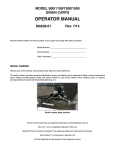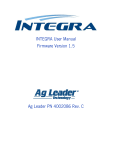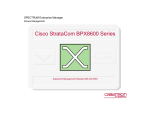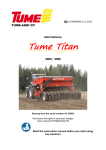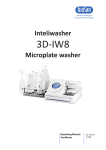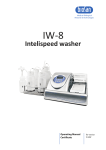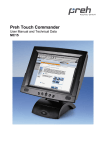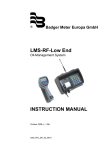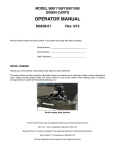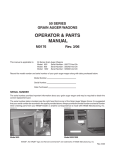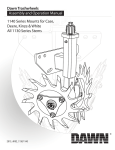Download Setting up Grower, Farm, Field Setting up
Transcript
Cobalt Cobalt - Basic Setup Service Manual Setting up Grower, Farm, Field 1. Turn display on. 2. Press the WRENCH icon. 3. Press the MANAGEMENT tab. 4. Press the GREEN PLUS sign to add a grower to the list. 5. Enter Business Name. 6. Press the GREEN CHECK when complete. 7. Press the SEASON tab at the top middle of screen. 8. Press the GREEN PLUS icon. 9. Type in Season Name. 10.Press the GREEN CHECK when complete. 11.Press the FIELD tab at top middle of the screen. 12.Press the GREEN PLUS icon. 13.Select or add the farm for the field and press the BLUE ARROW on bottom of screen. 14.Add field names to the list by pressing the GREEN PLUS icon. 15.Type in field name and press the GREEN CHECK. 16.Once all fields for that farm are in press the GREEN CHECK. 17.Repeat procedure for each farm and field combination. 18.Press the X in upper right hand corner to Exit. Setting up Hydraulic Drive and Clutch Control NOTE: The Cobalt display is a radar speed input only, manual clutch control display. The switch box is already configured with the master switch being the main on/off switch. Switches 1-4 are your 4 clutch section. (On 3660 TS machine switch 1-2 are used) Switch number 10 is individual control on the hydraulic drive. The master switch, switches 1-4 and switch 10 all have to be on in order for the planter to plant. 1. Press the CONTROL tab. 2. Check boxes for Enable Drives and Enable Clutches in the upper part of the screen. 3. Select the number of sections on the planter (3600, 3660 - 4; 3660 TS - 2; 3800 4 or 8) 4. Place the number of hydraulic drives in the hydraulic drive box (3600, 3660- 1; 3800 – 2). 5. Press controller setting and make sure settings are correct for your meter type (Mechanical or EdgeVac) referencing your owner’s manual for values. 6. Press the GREEN CHECK when complete. 7. Check the Display Rate Smoothing box in lower left corner of the screen. 8. Make sure the speed source is set to radar. 9. Press the CALIBRATE DISTANCE tab to calibrate Radar. a. This must be done through the Cobalt display and independent from the tractor calibration. 10.Press the BLUE ARROW to the right. 11.Enter in the distance you wish to drive to calibrate. 12.Press BLUE ARROW to the right. 13.Follow on-screen instructions. 14.Press GREEN CHECK when complete. 15.Press the X in upper right hand corner to Exit. 1 Rev. 9/11 TM Service Manual Cobalt - Basic Setup Cobalt Setting up a Product 1. Press the WRENCH icon. 2. Press the PRODUCTS tab in the lower right hand corner. 3. Press the GREEN PLUS icon on the right hand side. 4. Press the ADD PRODUCT. 5. Select the Crop Type by pressing the CROP TYPE bar. 6. Press the BLUE ARROW. 7. Enter Variety Manufacturer’s Name by pressing on keyboard. 8. Press the GREEN CHECK when complete. 9. Enter Variety Name by pressing on keyboard. 10.Press GREEN CHECK when complete. 11.Press GREEN CHECK again. 12.Repeat steps to add all crop products. 13.Select the X in the upper right hand side of the screen to exit products list. Programming the PMM 1. Press the WRENCH icon. 2. Press the MONITOR tab. 3. Press the PLANTER CONFIGURATION tab. 4. Enter number of total rows for front and rear. 5. Enter the smallest row spacing the planter will use. 6. Press the SPEED SENSORS tab in the upper middle of the screen. 7. Uncheck Magnetic Pickup if not applicable. 8. Select AUX for ground speed source. 9. Enter number of shaft rotation sensors. 10.Press the AUXILIARY SENSORS tab in the upper middle of the screen. 11.Enter the number of EdgeVac sensors and any other options on planter (ASD, Scales, etc.). 12.Press the GREEN CHECK. 13.Make sure all sensors, including auxiliary sensors are unplugged. 14.When the pop up window comes up press the GREEN CHECK. 15.Start plugging in sensors left to right, front to back. 16.Plug the Auxiliary sensor in order as listed on screen. 17.Press the GREEN CHECK when complete. 18.Check Enable Planter Monitor in lower left hand side of screen. 19.Press the GREEN CHECK to complete. Load Farm and Field to Begin Planting Operation 1. Press the large center tab in the upper half of screen and to the left of the wrench icon labeled START FIELD OPERATION. 2. Select the Growing Season and Grower. 3. Press the BLUE ARROW to the right. 4. Select the Farm and Field. 5. Press the BLUE ARROW to the right. 6. Select Crop Type and Product. 7. Press the GREEN CHECK. 2 Rev. 9/11 TM Cobalt Cobalt - Basic Setup Service Manual Rate Selection and Change 1. After following steps for loading farm and field press the TARGET icon in the lower left hand corner of the display. 2. Enter rates by selecting the TARGET/WRENCH icon in the lower right hand corner of the display. 3. Press the CALCULATOR for Rate 1 and Rate 2 and enter desired rate. 4. Press the CALCULATOR for increment to decide the rate of change. 5. Press the TARGET symbol in lower left hand corner of display. 6. Select the rate you desire by pressing 1 or 2 on the rate screen. 7. Press the TARGET in the lower left. 8. Press the large rectangle tab (with green sprocket) in the lower left hand side of display. 9. Press the CALCULATOR in the sds/rev tab and enter number of cells for your meter application (12 for mechanical corn meter; 60 for brush meter; 39 for EdgeVac corn; 60 for EdgeVac bean). 10.The SEED METER PRIME tab is used for EdgeVac equipped planters to fill the disc once the vacuum is turned on. 11.Press the TARGET icon in lower left had corner of display. Displaying the Bar Graph 1. 2. 3. 4. 5. In order to see the bar graph steps for loading farm, field must be followed first. Press the BAR GRAPH icon in the lower left hand side of the screen. By pressing the PLANTER AVERAGE tab, you can scan and freeze rows. Press the BAR GRAPH icon to return or bar graph screen. Press the WINDOW in the lower right hand side to cycle through other auxiliary sensors if applicable. For Cobalt Troubleshooting, reference the Vision Troubleshooting Guide. 3 Rev. 9/11 TM This page left blank intentionally. KINZE cobalt™ PLANTER CONTROL SYSTEM DISPLAY OPERATOR MANUAL M0231 Rev. 10/11 This manual is applicable to: Kinze Cobalt™ Planter Control System Display Firmware Version: 1.0 Record the serial numbers of your planter control system display and switch console, and the purchase date: Display Serial Number __________________________________________ Switch Console Serial Number____________________________________ Date Purchased________________________________________________ Measured Pulses Per Mile/KM (Radar Distance Sensor)_________________________________________ D10270801 SERIAL NUMBER The serial number plates are located on the back side of the display. It is suggested that your serial number and purchase date also be recorded above. The serial number provides important information about your display and may be required to obtain the correct replacement part. Always provide the model number and serial number to your Kinze® Dealer when ordering parts or anytime correspondence is made with Kinze Manufacturing, Inc. Kinze®, the Kinze® logo, Twin-Line®, Interplant®, EdgeVac®, Kinze Vision® and Kinze Cobalt™ are trademarks owned by Kinze Manufacturing, Inc. Rev. 2/10 This page left blank intentionally. Table of Contents M0231 Overview To The Owner . . . . . . . . . . . . . . . . . . . . . . . . 1 Warranty . . . . . . . . . . . . . . . . . . . . . . . . . . . . 2 Introduction . . . . . . . . . . . . . . . . . . . . . . . . . . 3 Specifications. . . . . . . . . . . . . . . . . . . . . . . . .5 System Overview General Information. . . . . . . . . . . . . . . . . . . . . . . 7 Kinze Cobalt System Power Up. . . . . . . . . . . 8 Kinze Planter Control System Wiring Diagram . . . . . . . . . . . . . . . . . . . . . . 10 Kinze Cobalt Planter Control System Installation Instructions . . . . . . . . . . . . . . . . 11 Home Screen. . . . . . . . . . . . . . . . . . . . . . . .12 Setup Screen . . . . . . . . . . . . . . . . . . . . . . . .12 General Setup . . . . . . . . . . . . . . . . . . . . . . . . . . . 13 General Setup Overview. . . . . . . . . . . . . . . 13 Management. . . . . . . . . . . . . . . . . . . . . . . . . . . . 14 Management Data Setup. . . . . . . . . . . . . . .14 Grower Setup Screen . . . . . . . . . . . . . . . . . 14 Season Setup Screen. . . . . . . . . . . . . . . . . 14 Field Setup Screen . . . . . . . . . . . . . . . . . . . 15 Product Setup . . . . . . . . . . . . . . . . . . . . . . . . . . . 16 Add a Product . . . . . . . . . . . . . . . . . . . . . . . 16 Import a Product . . . . . . . . . . . . . . . . . . . . . 17 Console Setup . . . . . . . . . . . . . . . . . . . . . . . . . . 18 General Tab. . . . . . . . . . . . . . . . . . . . . . . . . 18 Memory Tab . . . . . . . . . . . . . . . . . . . . . . . . .18 Advanced Tab . . . . . . . . . . . . . . . . . . . . . . . 19 Planter Bargraph . . . . . . . . . . . . . . . . . . . . . . . . 20 Population Box . . . . . . . . . . . . . . . . . . . . . . .20 Planter Average Settings . . . . . . . . . . . . . . .20 Auxiliary Sensor Box. . . . . . . . . . . . . . . . . . 21 Seed Sensors . . . . . . . . . . . . . . . . . . . . . . . 21 Alarms. . . . . . . . . . . . . . . . . . . . . . . . . . . . . 22 Target Rate . . . . . . . . . . . . . . . . . . . . . . . . . . . . . 24 Seed Meter Prime. . . . . . . . . . . . . . . . . . . . 24 Seed Meter Calibration . . . . . . . . . . . . . . . .25 Cobalt Configuration Kinze Planter Monitor . . . . . . . . . . . . . . . . . . . . 26 Planter Configuration. . . . . . . . . . . . . . . . . . 26 Seed Sensors Tab. . . . . . . . . . . . . . . . . . . . 26 Speed Sensors . . . . . . . . . . . . . . . . . . . . . . 27 Magnetic Coil Speed Sensor Calibration . . .27 Auxiliary Sensors . . . . . . . . . . . . . . . . . . . . .28 EdgeVac Calibration . . . . . . . . . . . . . . . . . . 28 Sensor Configuration. . . . . . . . . . . . . . . . . . 29 Sensor Information . . . . . . . . . . . . . . . . . . . 29 Alarms. . . . . . . . . . . . . . . . . . . . . . . . . . . . . 30 Rate Control . . . . . . . . . . . . . . . . . . . . . . . . . . . . 31 Speed Sensor Calibration . . . . . . . . . . . . . . 31 Controller Settings . . . . . . . . . . . . . . . . . . . .32 Channel Tabs . . . . . . . . . . . . . . . . . . . . . . . .32 Control Valve Settings. . . . . . . . . . . . . . . . . 32 Controller Settings for Kinze Hydraulic Drive. . . . . . . . . . . . . . . . . . . . . . .33 Auxiliary Tab. . . . . . . . . . . . . . . . . . . . . . . . .34 Diagnostics . . . . . . . . . . . . . . . . . . . . . . . . . . . . . 35 Device Information . . . . . . . . . . . . . . . . . . . .35 Memory. . . . . . . . . . . . . . . . . . . . . . . . . . . . 35 Display . . . . . . . . . . . . . . . . . . . . . . . . . . . . .35 Clutch Diagnostics . . . . . . . . . . . . . . . . . . . .36 Auxiliary Input Diagnostic . . . . . . . . . . . . . . 36 i Rev. 9/11 TM This page left blank intentionally. To The Owner M0231 Cobalt Kinze Manufacturing, Inc. thanks you for your patronage. We appreciate your confidence in Kinze farm machinery. Your Kinze planter has been carefully designed to provide dependable operation in return for your investment. This manual has been prepared to aid you in the operation and maintenance of the planter. It should be considered a permanent part of the machine and remain with the machine when you sell it. It is the responsibility of the user to read and understand the Operator Manual in regards to safety, operation, lubrication and maintenance before operation of this equipment. It is the user’s responsibility to inspect and service the machine routinely as directed in the Operator Manual. We have attempted to cover all areas of safety, operation, lubrication and maintenance; however, there may be times when special care must be taken to fit your conditions. Throughout this manual the symbol and the words DANGER, WARNING, and CAUTION are used to call attention to safety information that if not followed, will or could result in death or injury. NOTICE and NOTE are used to call your attention to important information. The definition of each of these terms follows: DANGER Indicates a hazardous situation which, if not avoided, will result in death or serious injury. WARNING Indicates a hazardous situation which, if not avoided, could result in death or serious injury. CAUTION, used with the safety alert symbol, indicates a hazardous situation which, if not avoided, could result in minor or moderate injury. NOTICE is used to address practices not related to personal injury. NOTE: Special point of information or machine adjustment instructions. WARNING Improperly operating or working on this equipment could result in death or serious injury. Read and follow all instructions in Operator Manual before operating or working on this equipment. WARNING Some photos in this manual may show safety covers, shields, or lockup devices removed for visual clarity. NEVER OPERATE OR WORK ON machine without all safety covers, shields, and lockup devices in place as required. NOTE: Photos in this manual may be of prototype machines. Production machines may vary in appearance. NOTE: Some photos and illustrations in this manual show optional attachments installed. Contact your Kinze Dealer for purchase of optional attachments. 1 Rev. 9/11 TM Cobalt Warranty M0231 The Kinze Limited Warranty for your new machine is stated on the retail purchaser’s copy of the Warranty And Delivery Receipt form. Additional copies of the Limited Warranty can be obtained through your Kinze Dealer. Warranty, within the warranty period, is provided as part of Kinze’s support program for registered Kinze products which have been operated and maintained as described in this manual. Evidence of equipment abuse or modification beyond original factory specifications will void the warranty. Normal maintenance, service and repair is not covered by Kinze warranty. To register your Kinze product for warranty, a Warranty And Delivery Receipt form must be completed by the Kinze Dealer and signed by the retail purchaser, with copies to the Dealer, and to the retail purchaser. Registration must be completed and submitted to Kinze Manufacturing, Inc. within 5 business days of delivery of the Kinze product to the retail purchaser. Kinze Manufacturing, Inc. reserves the right to refuse warranty on serial numbered products which have not been properly registered. If service or replacement of failed parts which are covered by the Limited Warranty are required, it is the user’s responsibility to deliver the machine along with the retail purchaser’s copy of the Warranty And Delivery Receipt to the Kinze Dealer for service. Kinze warranty does not include cost of travel time, mileage, hauling or labor. Any prior arrangement made between the Dealer and the retail purchaser in which the Dealer agrees to absorb all or part of this expense should be considered a courtesy to the retail purchaser. Kinze warranty does not include cost of travel time, mileage, hauling, or labor. 2 Rev. 9/11 TM M0231 Introduction The Cobalt planter control system display consists of a console, which is mounted on the tractor; seed tubes with computerized sensors, one of which is installed in each planter row unit; a PMM (Planter Monitor Module); a primary harness, which connects the console to the planter harness; and a planter harness (junction Y-harness and/or harness extension where applicable), to which the individual seed tube sensors connect. Cobalt D09180804 NOTE: PMM (Planter Monitor Module) with sensors and harness are sold seperately from the Cobalt display package. GENERAL INFORMATION The information used in this manual was current at the time of printing. However, due to Kinze’s ongoing product improvement, production changes may cause your planter control system display to appear or operate slightly different in detail. Kinze Manufacturing, Inc. reserves the right to change specifications or design without notice and without incurring obligation to install the same on machines previously manufactured. Right hand (R.H.) and left hand (L.H.), as used throughout this manual, are determined by facing in the direction the machine will travel when in use, unless otherwise stated. 3 Rev. 9/11 TM This page left blank intentionally. Specifications M0231 Cobalt Kinze COBALT Planter Control System display Absolute Voltage Range. . . . . . . . . . . . . . . . . . . . . . . . . . . . . . . . . . . . . . . . . . . . . . . . . . . . . . . . . . . 0 to 60v Audio . . . . . . . . . . . . . . . . . . . . . . . . . . . . . . . . . . . . . . . . . . . . . . . . . Integral Speaker With Volume Control Card Slot. . . . . . . . . . . . . . . . . . . . . . . . . . . . . . . . . . . . . . . . . . . . . . . . . . . . . (1) Type 1 Compact Flash Slot Connector. . . . . . . . . . . . . . . . . . . . . . . . . . . . . . . . . . . . . . . . . . . . . . . . . . . . . . . . . . . . . . . . (1) 28-Pin AMP Display Features. . . . . . . . . . . . . . . . . . . . . . . . . . . . . . . . . . . Sunlight Readable; Backlight Intensity Control Display Size . . . . . . . . . . . . . . . . . . . . . . . . . . . . . . . . . . . . . . . . . . . . . . . . . . . . . . . 6.5" Diagonal Color LCD Enclosure. . . . . . . . . . . . . . . . . . . . . . . . . . . . . . . High Impact Polycarbonate - Chemical And UV Resistant Environmental Operating Temperature. . . . . . . . . . . . . . . . . . . . . . . . . . . . . . . . . . . . . . . . . . . . 14˚ to 149˚F Full Function Voltage Range. . . . . . . . . . . . . . . . . . . . . . . . . . . . . . . . . . . . . . . . . . . . . . . . . . . . . . . . 8 to 18v Input/Output. . . . . . . . . . . . . . . . . . . . . . . . . . . . . . . . . . . . . . . . . . . . . . . . . . . . . . CAN, Serial Port (RS232) Maximum Current Draw. . . . . . . . . . . . . . . . . . . . . . . . . . . . . . . . . . . . . . . . . . . . . . . . . . . . . . . . . . . . . . . 2A Mount Dimensions. . . . . . . . . . . . . . . . . . . . . . . . . . . . . . . . . . . . . . 1½" Diameter Balls And 5" Arm Length Mounting System. . . . . . . . . . . . . . . . . . . . . . . . . . . . . . . . . . . . . . . . . . . . . . . . . . . . . . . . . . . . Ram® Mount Operating Voltage Range. . . . . . . . . . . . . . . . . . . . . . . . . . . . . . . . . . . . . . . . . . . . . . . . . . . . . . . . . . 6 to 19v Power Loss Protection for Shutdown. . . . . . . . . . . . . . . . . . . . . . . . . . . . . . . . . . . . . . . . . . . . . . . . . . . . Yes Power Override Button. . . . . . . . . . . . . . . . . . . . . . . . . . . . . . . . . . . . . . . . . . . . . . . . . . . . . . . . . . . . . . . Yes Reverse Voltage Protection . . . . . . . . . . . . . . . . . . . . . . . . . . . . . . . . . . . . . . . . . . . . . . . . . . . . . . . . . . . Yes Storage Temperature . . . . . . . . . . . . . . . . . . . . . . . . . . . . . . . . . . . . . . . . . . . . . . . . . . . . . . . . . -22˚ to 158˚F Touch Screen Area. . . . . . . . . . . . . . . . . . . . . . . . . . . . . . . . . . . . . . . . . . 6.5" Diagonal; Chemical Resistant D09180804 Planter Control System Display Smart Switch Box Smart Switch Box Enclosure. . . . . . . . . . . . . . . . . . . . . . . . . . . High Impact Polycarbonate/ABS - Chemical And UV Resistant Outside Dimensions. . . . . . . . . . . . . . . . . . . . . . . . . . . . . . . . . . . . . . . . . . . . . . . . . . . . . . 10.4" x 2.9" x 2.1" Weight. . . . . . . . . . . . . . . . . . . . . . . . . . . . . . . . . . . . . . . . . . . . . . . . . . . . . . . . . . . . . . . . . . . . . . . . . 1.8 lbs. 5 Rev. 9/11 TM This page left blank intentionally. M0231 General Information Kinze Cobalt System The Cobalt planter control system display consists of a console, which is mounted on the tractor; seed tubes with computerized sensors, one of which is installed in each planter row unit; a PMM (Planter Monitor Module); a primary harness, which connects the console to the planter harness; and a planter harness (junction Y-harness and/or harness extension where applicable), to which the individual seed tube sensors connect. NOTE: PMM (Planter Monitor Module) with sensors and harness are sold seperately from the Cobalt display package. CAN-Bus Technology The Cobalt system uses Controller Area Network (CAN) technology. CAN systems are comprised of individual modules, each with their own high speed processor, connected through a high-speed communications cable. CAN has many benefits, including greater ability to configure and expand the system, compatibility, simpler installs with less wiring and increased system dependability. Physical Description The Cobalt monitor has been built to withstand the harsh environment associated with today’s agricultural industry. The weathertight enclosure is designed to seal out any dirt and moisture that is encountered during normal operating conditions NOTE: The card door slot must be fully closed for the Cobalt monitor to remain weathertight. System Features: • 6.5" color touch screen • Sunlight-readable screen • Internal memory • Color bargraph simultaneously Cobalt displays up to 36 rows • Control seed rate and single row air clutches manually NOTE: The Cobalt is non-GPS compatible. Data Card Usage The Cobalt uses a compact flash card for transferring data in and out of the display. The system is compatible with all current card sizes; 64 MB is the minimum recommended size for use with the system. Color Touch Screen The Cobalt display features a 6.5" color touch screen. The touch screen allows quick navigation through the screens on the display without the need for any external keypad or mouse devices. Here are a few key things to remember if you are new to using a touch screen device: • Do not use any sharp objects for running the touch screen device, this could result in damage to the display. Using the tip of a finger is the recommended method of operating the Cobalt display touch screen. • Do not use any harsh chemicals to clean the touch screen. Using a damp soft cloth or an anti-static wipe made specifically for cleaning computer displays is the correct way to clean the screen and the Cobalt enclosure. • The touch screen requires only a gentle touch of about half-second in duration to operate correctly. A common mistake new users make is to try to navigate too quickly through the system by using firm taps on the monitor screen. Instead, use gentle presses on this screen. • Rugged, sealed enclosure • Direct access keys allow one-touch access to home, setup, and summary/report screens • Adjustable volume control • Integrated seed monitor functions, no need for other KPM monitors 7 Rev. 9/11 TM Cobalt General Information M0231 Kinze Cobalt System Power Up The Kinze Cobalt™ display comes with an AC power supply to enable familiarization and configuration away from the tractor. Prior to installing any Kinze Cobalt system hardware, use this guide and step through the initial configuration process. D09180804 D10270801 Compact Flash Card Slot On/Off Switch 28-Pin Connector Front View - Kinze Cobalt Display Rear View - Kinze Cobalt Display Compact Flash Card Slot 28-Pin Connector The compact flash card slot has a sensor that allows the display to know when the door is open or closed. If the door is opened when a card is in the display, an on-screen warning will appear indicating when the card can safely be removed. The Kinze Cobalt display comes with a compact flash card. The compact flash card will be required to transfer files for the Kinze Cobalt to a desktop computer. The 28-Pin round pin connector contains CAN, RS-232 serial, and system power and ground connections. 8 Rev. 9/11 TM This page left blank intentionally. Cobalt General Information M0231 Kinze Planter Control System Wiring Diagram CO1b 10 Rev. 9/11 TM M0231 General Information Cobalt Kinze Cobalt Planter Control System Installation Instructions All machine installation and mounting kits are shipped with instructions specific to that kit. Instructions include special details relating to mounting, wiring and display configuration. Mounting The Kinze Cobalt™ Display Mount the display to a secure support inside the vehicle cab. The following must be considered when choosing a mounting location. NOTICE: If drilling holes is required during the mounting process, care must be taken to ensure that damage is not done to existing vehicle wiring, mechanicals, or cab structure. Refer to vehicle manufacturer documentation for specific details on your equipment. Follow all OEM instructions, cautions, and warnings when working around equipment. • Display must be readily accessible to the machine operator. • Display must not obstruct the machine operator’s normal driving view. • Display must not interfere with or limit access to any of the existing machine controls. • Route and secure the Kinze Cobalt system cabling without interfering with other machine controls. 11 Rev. 9/11 TM General Information Cobalt Home Screen CO7 CO10 CO11 CO5 CO12 Setup Screen CO8 Home Screen Before Setup CO9 M0231 Home screen button is the default screen. You can return to this screen from other locations by pressing the Home icon it consists of four buttons, described from left to right. Diagnostic button opens windows that display Device Information, Memory, Display, Clutch Diagnostics and Auxiliary Input Diagnostics. For more information, see the Diagnostics section. Setup Window The Setup window displays five buttons: Management, Console, Monitor, Control and Products. Each of these are described in their own section of this User Manual. NOTE: Press the Close (X) button to exit or cancel wizard and return to the field setup screen. Start field operation button opens the Field Operation Wizard, where you can enter information relating to your Growing Season, Farm, Field, Crop Type and Product. For more information, see the Start Field Operation section. Setup button opens the Setup window, which is described briefly in the Setup section at the end of this chapter. View operation summary button opens the Select Summary window, where you can select different configuration settings for Seasons, Grower, Farm, Field and Product. NOTE: The summary button at the bottom of the Select Summary window allows you to view each region’s Variety, Average Rate, Total seeds planted, Area and the date that region was created. NOTE: To exit a screen that does not show the Home icon press the “X” in the top right corner of the screen to return to the Home Screen. 12 Rev. 9/11 TM General Setup M0231 General Setup Overview CO11 The start of Field Operations begins at the Home screen. First press the Start Field Operation button. The Field Operation Wizard appears, as shown below. Cobalt 3. Last, enter in a Crop Type and Product by using the drop down arrows to select existing ones, or by pressing on the Add (plus sign) button to create new ones. When finished, press the checkmark box to return to the Home screen. CO14 CO13 Home screen after configuration Field Operation Wizard Follow the steps in the Wizard to create an operating configuration. 4. When you return to the Home Screen, the Grower, Farm and Field information now appears in the Start Field Operation box. 1. First, enter a Growing Season and Grower either by using the drop down arrows to select existing ones, or by pressing on the Add (plus sign) button to create new ones. Press the arrow key at the bottom of the window to proceed to the next step. 2. At the next window, add Farm and Field information either by using the drop down arrows to select existing ones, or by pressing on the Add (plus sign) button to create new ones. Press the arrow key at the bottom of the window to proceed to the next step. 13 Rev. 9/11 TM Management Cobalt M0231 Management Data Setup Season Setup Screen CO15 The Season Tab is used to set up the crop season. The season is defined as the calendar year that the crop, relating to the current field operation, will be harvested. Pressing the Management button on the Setup window brings up the Management window, which includes the Grower, Season and Field tabs. CO17 CO60 Grower Setup Screen The Grower Tab is used to set up the businesses or people that own one or more farms. • Press the Add (plus sign) button to add a grower. • Press the Delete (minus sign) button to delete a grower. • You may edit an existing name of a Grower by highlighting that name and pressing the on-screen keyboard. • Press the Import .MSF button to import a management setup file for grower, farm and field information exported from desktop software and stored on your compact flash card. The seasons are displayed in lists, with the active season displayed in bold face type. All new data is logged to the active season; therefore a season must be set as active before you can log any new data to it. • Press the Add (plus sign) button to add a season. • Press the Delete (minus sign) button to delete a season. • You may edit an existing name of a season by highlighting that name and pressing the on-screen keyboard. • Press the Set Active button to set the season selected in the summary list box to the active season. • Press the Season Reminder button to set the date that the system will prompt the user to create a new season. NOTE: To expand a list press the “+” or “-” sign to the left of the list. 14 Rev. 9/11 TM M0231 Management Field Setup Screen The Field tab is used to set up fields and all descriptive information relating to them. CO18 Cobalt To add a farm/field press the Add (plus sign) button on the field setup screen and the field setup wizard appears. 1. The first screen allows you to select a farm or add a new farm. Press the blue arrow to continue to the next step. 2. At the next window, press the Add (plus sign) button to add to the field list 3. Press the check box to return to the field tab. NOTE: Press the Close (X) button to exit or cancel wizard and return to the field setup screen. Each farm is shown in a list, with the fields within that farm as subcomponents within that list. NOTE: To expand a list press the “+” or “-” sign to the left of the list. • Press the Add (plus sign) button to add a farm/ field. • Press the Delete (minus sign) button to delete a farm/field. • You may edit an existing name of a farm/field by highlighting that name and pressing the on-screen keyboard. • Select the field and press the Information button to display the Field Information window. This window displays the Farm, Area, FSA Number (the U.S. Farm Service Agency’s four-digit number) and FSA Area (tillable acres). Press the check box to return to the field tab. CO19 Field Information window 15 Rev. 9/11 TM Product Setup Cobalt Add a Product CO20 Pressing the Products button in the Setup window brings up the Products window, where you can add new products or edit existing products for planting and seeding. M0231 To add a product, press the Add (plus sign) button. The Product Options window appears. CO22 CO21 Product Options window 1. Press the Add Product button. The Variety Setup Wizard appears, where you can add a Variety. Products Window Use the Select Type drop down box to select the crop type of your desired Product. • The Add (plus sign) button opens the Product Options window, where you can Add a Product or Import a Product. More information is provided later in this section. 2. Use the drop down arrows to select a Crop Type, and then press the blue arrow key at the bottom of the window to proceed to the next step. 3. Use the on-screen keyboards to enter in a Variety Manufacturer (optional) and a Variety Name. When finished, press the checkmark box to return to the Product window. • The on-screen keyboard button allows you to edit the Product Name. • The Wrench button opens the Product Settings window, where you can edit the Manufacturer name. • The Delete (minus sign) button allows you to remove a product. NOTE: The product name must be highlighted to edit or delete. 16 Rev. 9/11 TM M0231 Product Setup Cobalt Import a Product To import a product from desktop software, you must import an .msf file. Press the Import Product button on the Product Options window, and the Product Import Wizard appears. NOTE: In order for you to import products from an .msf file, you must have first imported Grower, Farm and Field information from an .msf file at the Grower Tab on the Management window. 1. At the Product Import Wizard, use the drop down menus to select a Product and Product Type. Press the blue arrow key to continue to the next step. 2. At the next window, use the on-screen keyboards to enter a Manufacturer and a Common Name. Press the blue arrow key to continue to the next step. 3. At the last window, use the on-screen keyboard to edit a Product Name. Press the checkmark box to finish and return to the Products window. 17 Rev. 9/11 TM Console Setup Console Setup Cobalt CONSOLE CO23 M0231 Memory Tab Press the Console button on the Setup window to access the Console window. The Console window contains settings related to Time, Date, console screen settings, operating units and external card information. It consists of three tabs: the General Tab, the Memory Tab and the Advanced Tab. The Memory Tab displays the used and free space available on the external data card, as well as the percentage of memory used on that card. The Memory Tab also includes the following items: CO25 General Tab CO24 Console - Memory Tab Console - General Tab The General Tab consists of the following items: • Time and Date settings. To change these, press on this button and use the up and down arrow keys to adjust the hours, minutes, A.M./ P.M. settings, month, date and year. To make these changes effective, press the checkmark/ Shutdown button. NOTE: The Cobalt monitor will then shut down immediately. If you do not want to shut the monitor down, press the Close (Red X) button. • Brightness and volume percentages. To change these, press the Brightness/Volume button and use the up and down arrow buttons to change the percentage of the Display Brightness and Speaker Volume. • Calibrate Touchscreen. Press this to launch the Touch Screen Calibration wizard. Calibrate the touch screen by following the on-screen instructions. • Time Zone. Use the drop down menu to select your time zone. • Create Backup. Press to create a backup file of all configuration settings, products, and GrowerField Management data structure on the external memory card. Backup files are stored using the .ibk file format. • Restore Backup. Press to restore a backup file from the external data card to the internal memory of the Cobalt monitor. • Copy. Press to copy all logged data to the external memory card. Log files are stored using the .ilf file format. • Upgrade. Press to load program upgrade files from the external storage card. • Browse Files. Press to view all files on the external memory card. • Clear Internal Memory. Press this button to clear the internal memory of the monitor. The system will present a warning dialog box and ask if you would like to create a backup file prior to clearing the memory. NOTE: The Cobalt monitor will be returned to a “new out-of-box” unconfigured state when the memory is cleared. • Country/Language Selection. The only option offered at this time is the English language. • Operating Units. Select either Imperial or Metric. 18 Rev. 9/11 TM M0231 Console Setup Cobalt Advanced Tab CO26 Console - Advanced Tab NOTE: All functionality on the Advanced tab is reserved for use by Kinze. Do not change any setting on this page without specific instruction from Kinze. 19 Rev. 9/11 TM Planter Bargraph Cobalt Planter BARGRAPH CO27 Return to the home screen and press the Bargraph icon to open the Population Monitor Bargraph. This bargraph consists of a number of bars representing row units. Each bar’s row height represents that row’s population in comparison with the planter average. M0231 Planter Average Settings Press the Planter Average box, and a window appears with three buttons: Planter, Freeze and Scan. CO29 CO28 • Planter. Planter Mode is the default setting for the Rate/Spacing Display. This mode specifies the instantaneous average population and seed spacing for the entire planter. Planter Bargraph Population Box In the Population box, the Rate Display and Spacing Display are where Instantaneous Average Rate and Spacing are displayed either for the entire planter, or for each row, depending upon the Planter Average Settings. • Freeze. Freeze Mode specifies that the Rate/ Spacing Display continuously shows only one specified row chosen by the operator. • Scan. Scan Mode specifies the Rate/Spacing on a row-by-row scan on all the planter’s row units, displayed in sequence from left to right. 20 Rev. 9/11 TM M0231 Planter Bargraph Cobalt Auxiliary Sensor Box The Shaft Speed box on the lower-right hand side of the screen displays a number of display items, listed in order of appearance. You can show the following display items by touching this box. • The Shaft Speed displays the speed of the planter drive shafts, in RPM. • Edge Vac. The EdgeVac® level is a measurement of seed meter vacuum. This measurement, shown in inches of water, is displayed for each vacuum fan. • Down Pressure. The Pneumatic Down Pressure is a measurement of down force, shown in pounds (kilograms), that the air bag places on the row unit. • Tank Weight. The weight of seed in each tank. • Tank Pressure. The air pressure level for the Air Seed Delivery (ASD) system. Seed Sensors You can review the seeds per second (sds/sec) and seeds per acre (sds/ac) measurement of each row unit by pressing on the bargraph of any individual row. The Seed Sensors window appears, as shown below. Scroll down this window with the scroll bar on the right to review these numbers for all row units. CO30 Seed Sensor Window 21 Rev. 9/11 TM Planter Bargraph Cobalt M0231 Alarms If a row unit drops below a user-defined threshold, the bar turns red, an audible alarm sounds and an error message appears on the window. Planter Monitor Alarms at Startup Startup Error Message Possible Cause “Sensors Calibrating PMM Startup wait for calibration” Solution Wait for Planter Monitor Module (PMM) to finish before beginning operation. “(Row #) sensor not Population sensor did not Acknowledge the error by pressing OK. Check the LED on the detected” begin communicating with sensor to see if it is working properly. If it has failed, then replace the PMM the sensor. Refer to the Kinze Planter Operator’s manual for further instructions. “Clean or replace Population sensor dirty sensor (Row #) as necessary” Press OK to dismiss the error. Then clean the sensor and restart the system. “(Row #) mux bus Population sensor’s mux Press OK to dismiss the error. The display then replaces the data line short to mux bus signal wire is shorted message window with an alarm text on the header bar at the bus ground” to ground top of the Run screen. This alarm text continues until the wire is fixed or the sensor is disabled. Inspect the wire at the first opportunity. “(Row #) mux bus Population sensor’s mux Press OK to dismiss the error. The display then replaces the data line short to mux bus signal wire is shorted message window with an alarm text on the header bar at the bus power” to power wire. top of the Run screen. This alarm text continues until the wire is fixed or the sensor is disabled. Inspect the wire at the first opportunity. 22 Rev. 9/11 TM M0231 Planter Bargraph Cobalt Planter Monitor Alarms during Operation Error Message During Operation Possible Cause Solution “(Row #) mux bus data line short to mux bus ground” Population sensor’s mux bus signal wire is shorted to ground. Press OK to dismiss the error. The display then replaces the message window with an alarm text on the header bar at the top of the Run screen. This alarm text continues until the wire is fixed or the sensor is disabled. Inspect the wire at the first opportunity. “(Row #) mux bus data line short to mux bus power” Population sensor’s mux bus signal wire is shorted to power wire. Press OK to dismiss the error. The display then replaces the message window with an alarm text on the header bar at the top of the Run screen. This alarm text continues until the wire is fixed or the sensor is disabled. Inspect the wire at the first opportunity. “(Row #) communication lost” Seed tube sensor stops communicating with the PMM. Press OK to dismiss the error. The display then replaces the message window with an alarm text on the header bar at the top of the Run screen. This alarm text continues until the wire is fixed or the sensor is disabled. Inspect the wire at the first opportunity. “(Inner or Outer; Right or Left) Shaft Communication Lost” Transmission sensor stops communicating with the PMM. Press OK to dismiss the error. The display then replaces the message window with an alarm text on the header bar at the top of the Run screen. This alarm text continues until the wire is fixed or the sensor is disabled. Inspect the wire at the first opportunity. “(Left or Right) Edge-Vac sensor communication lost” Edge-Vac sensor stops communication with the PMM. Press OK to dismiss the error. The display then replaces the message window with an alarm text on the header bar at the top of the Run screen. This alarm text continues until the wire is fixed or the sensor is disabled. Inspect the wire at the first opportunity. “Voltage Error Alarm” Occurs if the battery voltage drops below 10 volts, or rises above 15 volts. Check tractor’s electrical system. “(Row #) Seed Rate Alarm” The seed rate of one or more rows is less than the alarm threshold setting and the corresponding transmission shaft sensor detects rotation. Press OK to dismiss the error. If the alarm state is still present, the graph will state the rows where the errors are occurring, and the Title Bar will flash the type of alarm. Inspect row units to confirm that each has seed, and that all mechanical drive shaft parts are working properly. Low pressure in the pneumatic down pressure system. Press OK to dismiss the error. Check for air leaks and compressor failure. “Low Down Force Air Pressure” NOTE: If desired, the alarm threshold for the row unit may be set to 0%, which will silence the seed rate alarm. However, the bargraph will continue to operate and the row will still be calculated in the planter average population. For instructions on changing the alarm threshold, see the Alarms description in the Monitor section of this User Manual. 23 Rev. 9/11 TM Target Rate Cobalt CO31 M0231 Pressing the Target Rate icon opens the Target Rate window, as shown below. Rate Control window Seed Meter Prime Target Rate window The Target Rate window includes the following items: Rate 1 and 2. The Rate 1 and Rate 2 settings represent preset planting rates that allow operators to quickly change between desired target rates for each individual product. Pressing these buttons will change the Target Rate setting in the upper left hand side of the window. The Seed Meter Prime is used to charge the seed meter when filling with seed, or after turning on the vacuum for Edgevac® planters. To begin, press the Seed Meter button in the Target Rate window. The Meter Calibration window appears, as shown below. CO34 Manual Valve Control. The Manual Valve Control button allows operators to specify the position of the control valve. Seed Meter. The Seed Meter button displays the number of hydraulic drive motors controlled by the Cobalt monitor. Additionally, it displays the speed of the Seed Meter, in RPM. Pressing the Seed Meter button opens the Meter Calibration window, where you can perform a Seed Meter Prime and a Seed Meter Calibration. The Meter Calibration window is described below. Meter Calibration window 1. Press the Seed Meter Prime button. 2. A window appears, stating “Seed Meter Prime in Progress.” At the same time, the Seed Meter turns one revolution. Rate Control. The Rate Control button opens the Rate Control window, where you can adjust the Rate 1 and 2 settings. Additionally, you can adjust the Rate Increment setting, which determines the amount that the target rate setting changes when the up and down arrow key is pressed on the Target Rate window. 24 Rev. 9/11 TM M0231 Target Rate Seed Meter Calibration The Meter Calibration number allows the seed meter to communicate the correct seed population to the Cobalt monitor. Assuming the Controller Settings are correct for the seed rate, this Meter Calibration number, which is based on the number of cells on the seed meter, should not need to be adjusted. However, you may wish to recalibrate before changing seed types and treatments. You should also recalibrate if the as-applied seed rate does not match the population shown on the planter monitor. • The seed rate meter calibration does not recalibrate any previously-logged planting data. • This calibration number applies to a specific crop type, i.e., corn. Normally, you should not need to recalibrate when switching varieties within the same crop type. • Before beginning a calibration, make sure that you have primed the seed meter. 1. To begin, press the Calibrate button on the Meter Calibration window. Cobalt 8. When the meter is finished dispensing seed, the button will change back to its original green color, and will once again display the word Start. Press the arrow box to continue. 9. Use the numeric keypad to enter the number of dispensed seeds that you counted. Press the arrow box to continue. 10.The calibration is complete. The meter calibration number appears, shown in seeds per revolution. From this point, you can either: • Repeat the calibration, or • Press Finish to complete the calibration. 11.As an optional step, you can apply the seed meter calibration number to all of the planter drives. Press either Yes or No and the calibration is now complete. NOTICE: When the planter is equipped with EdgeVac seed meters, and the number of seeds collected does not match the seeds/rev display, check the singulators and vacuum settings and then recalibrate. 2. The Meter Calibration Wizard opens. At the same time, a warning appears, stating the following: “Maintain a safe distance from the planter during the calibration routine. The planter should be lowered near the ground with the seed meter fully charged with seed and all necessary fans and/or auxiliary metering devices on.” Acknowledge this warning by pressing the checkmark box. 3. Use the drop down menu to select the drive to calibrate, then press the arrow box at the bottom right hand side of the window to continue. 4. Use the numeric keypad to enter the simulated ground speed. Press the arrow box to continue. 5. Use the numeric keypad to enter the Simulated Target Rate, in seeds per acre. Press the arrow box to continue. 6. Press the green-colored Start button to begin dispensing seed. 7. The seed meter turns for five revolutions. As the seed meter dispenses seed, the button will change its color to red, and a message informs you that the seed dispension is in process. 25 Rev. 9/11 TM Kinze Planter Monitor Cobalt CO35 Pressing the Monitor button opens the Kinze Planter Monitor Setup window, as shown below. This window is where you can adjust configuration settings for the Planter, Sensor and Alarms. M0231 Planter Configuration The Planter Configuration window includes three tabs, the Seed Sensors tab, the Speed Sensors tab, and the Auxiliary Sensors tab. CO36 Seed Sensors Tab The Seed Sensors tab is where you can set the number of front and rear units, and minimum row spacing. Kinze Planter Monitor Setup • The Planter Configuration button opens the Planter Configuration window. • The Sensor Configuration button shows the Sensor Configuration window. • The Alarms button pulls up the Seed Monitor Alarms window, where the operator can set a threshold for the alarm at 10%, 50%, or 70% or a user-specified percentage; or disable the alarm entirely. Planter Configuration - Seed Sensors tab • Front Units and Rear Units - Use the up and down arrow keys to adjust the number of front and rear planting units, if necessary. • The Sensitivity (Seed Size) ensures dust and other debris are filtered out and only actual seeds are counted. Sensitivity threshold is set to a default for a selected crop which is adequate for most conditions. • The Row Spacing window shows the minimum row spacing of the planter. Use the numeric keypad to adjust the Row Spacing. • Press the check mark button to save information and return to the Kinze Planter Monitor Setup screen. Press the Close (red X) button to exit and cancel. • The Reset clears seed tube memory and allows you to re-learn all seed sensors. 26 Rev. 9/11 TM M0231 Kinze Planter Monitor Speed Sensors The Speed Sensors tab is where you can set your Ground Speed Source for the PMM, Calibrate Magnetic Pickup, and set the number of Shaft Speed Sensors. CO38 Cobalt Magnetic Coil Speed Sensor Calibration Kinze Cobalt customers who have a magnetic coil speed sensor must check the Magnetic Pickup check box on the Planter Configuration window when the first enter a configuration. This setting should then be left unchanged. These customers will need to calibrate the Magnetic Coil Speed Sensor at least once per season. To do this, press the Monitor button and go to the Kinze Planter Monitor Setup. Press Planter Configuration, and go to the Speed Sensors tab. Check the Magnetic Pickup check box (if unchecked) and then press the Calibrate button. The Magnetic Coil Speed Sensor Calibration wizard appears. Complete the configuration procedure by following the steps outlined on this wizard. Planter Configuration - Speed Sensors tab • Ground Speed Source - The Ground Speed Source drop down box selects the type of speed source for the planter monitor. Select either Aux (Radar) or Planter Monitor Module (PMM) 1. Enter distance of calibration The default distance for calibrating the magnetic coil speed sensor is 100 feet (50 meters). If you wish to calibrate at another distance, enter the new distance. Press the arrow box to continue. NOTE: This speed selection only affects the PMM. The Cobalt monitor’s ground speed source must still be selected under the Rate Control screen. 2. Drive from start to end points Position the vehicle at the start marker. Press the green-colored Start button and drive the vehicle for the predetermined distance. • Magnetic Pickup - Check the Magnetic Pickup check box only if the planter is equipped with the Magnetic Pickup Sensor. This setting should then be left unchanged. For information on calibrating the Magnetic Coil Speed Sensor, see the end of this chapter. NOTE: The Cobalt display must be set on 0.0 before you begin driving the calibration distance. NOTE: Customers who do not have the magnetic pickup sensor who check this box will see a window stating “Bad Configuration: No Magnetic Pickup sensor currently found.” 4. Calibration complete The speed sensor calibration number has been calculated from the actual distance driven. Press the checkmark box to complete calibration and store the calculated value. • Shaft RPM Sensors - Use the up and down arrows to adjust the number of Shaft RPM Sensors, if necessary. • Press the check mark button to save information and return to the Kinze Planter Monitor Setup screen. Press the Close (red X) button to exit and cancel. 3. Stop at end of calibration distance When the vehicle crosses the end marker of the predetermined distance, press the red-colored Stop button. Press the arrow box to continue. NOTES: • Calibration settings can be manually adjusted if desired by pressing Enter CAL Number and making small changes to the setting. • To verify the calibration, repeat the previous steps. 27 Rev. 9/11 TM Cobalt Kinze Planter Monitor M0231 Auxiliary Sensors EdgeVac Calibration The Auxiliary Sensors tab is where you specify the number of EdgeVac sensors and calibrate these sensors. Customers who have purchased the EdgeVac seed meters should perform an EdgeVac Calibration once a year to make sure that it is correct. Use the numeric keypad to enter the actual value taken from the handheld analog gauge taken at the seed meter. NOTE: Enter the level of vacuum measured at the row unit. Measurements should be taken with fans on and seed meter charged. CO43 Planter Configuration - Auxiliary Sensors tab • EdgeVac sensors - Use the arrows to enter the number of EdgeVac sensors on your planter. • Press the check mark button to save information and return to the Kinze Planter Monitor Setup screen. Press the Close (red X) button to exit and cancel. NOTE: You will also need to calibrate the EdgeVac sensors once per year. This process is described later in this chapter. EdgeVac Calibration window Other check boxes on the Auxiliary Sensors tab include: • Tank Weight - For ASD Scales if equipped. • Tank Pressure - ASD tank operation pressure. • Down Pressure - Check this box if the planter has pneumatic down pressure. • Air Compressor - Selected if you have an air compressor. Indicates when air compressor is low. • Sensor Detection - press the green check mark on the Kinze Planter Monitor Setup screen. “This will require a muxbus detection Continue?” screen will appear. Press the green check mark. • Oil Sensor - Not used. • SDS - Not used. NOTE: Be sure PMM module cable is plugged into main muxbux harness. Plug in rear rows L to R and front rows L to R, auxiliary sensors, EdgeVac sensors, and Pneumatic sensors. When all sensors have been found a box will appear to confirm. Press the check mark to continue. 28 Rev. 9/11 TM M0231 Kinze Planter Monitor Cobalt Sensor Configuration Sensor Information The Sensor Configuration window, shown below, is for system maintenance of the Population Monitor. The Sensor Information window displays hardware information for each seed tube sensor and also each seed sensor. Technical support may request that you look at this window to help in diagnosing a problem. CO40 CO41 Sensor Configuration window • The Install button installs a row sensor. Sensor Information window • The Remove button removes the highlighted sensor of any type. • ID - The hardware ID number is a unique number for each sensor on the muxbus. • The Revive button allows the display to reattempt communication with the highlighted sensor of any type. • Serial Number - The Serial Number varies for each individual unit of seed sensor and seed tube sensor. • The Ignore button tells the monitor to cease communications with a row sensor. • Model Number - The Model Number is shared by each unit of the same model of seed tube sensor. • The View button shows the Sensor Information window. For more information, see the Sensor Information section below. • Baud Rate - The Baud Rate number is the speed of transmission between the muxbus sensor and the PMM module. 29 Rev. 9/11 TM Cobalt Kinze Planter Monitor M0231 Alarms To view the Seed Monitor Alarms window, go to Setup and press the Monitor button. At the Kinze Planter Monitor Setup window, press the Alarms button. The Seed Monitor Alarms window appears, as shown below. CO42 Seed Monitor Alarms window You can change the alarm threshold for each individual row unit, or for an individual section, or the whole planter. To change the threshold of an alarm, highlight the row unit, then press either a given percentage number (10%, 50%, 70%, or use the numeric keypad to create your own value). The alarm will then sound only when the population drops below that numeric threshold value. NOTES: • The default alarm setting is at 50%. • If you wish to turn the threshold of the alarm to zero, press the Disable button. 30 Rev. 9/11 TM Rate Control M0231 Rate Control You can begin planting with the Kinze Cobalt monitor by entering Rate Control information in six steps. 1. Press the Setup (wrench) tool screen opens. , and the Setup From there, press the Control button and go to the Rate Control screen, as shown below. Cobalt Speed Sensor Calibration Press the Calibrate Distance button to begin a Speed Sensor calibration. The Speed Sensor Calibration wizard appears. Follow the instructions detailed in the wizard. These are explained in further detail below. 1. Select Ground Speed Sensor Type The sensor type of Radar is preselected. Press the arrow button to continue. 2. Mark the Start and End Points of the Following Known Distance The system defaults to 100 feet (50 meters) distance for calibration. Enter in a different number, if desired. 3. Start Driving Course Rate Control Screen 2. At the Rate Control screen, check the Enable Drives check box to make the Kinze Hydraulic Drive available. • Model 3600 or Model 3660 - 1 drive. 4. Calibration Complete • Model 3800 - 2 drives. Follow the on-screen directions and press the green Start button to begin the calibration process. Press the checkmark box to complete calibration and store the calculated value. 3. If you are using Clutch Control, check the Enable Clutches checkbox. • Model 3600 or Model 3660 select 4 Sections. NOTE: Calibration settings can be manually adjusted if desired by pressing Enter CAL Number and making small changes to the setting. • Model 3800 - Select 4 or 8 Sections depending of operator preference. NOTE: The switch box under the Cobalt display needs a minimum of the master switch, switches 1-4, and switch 10 on in order for the hydraulic drive system to operate. 4. Select a Speed Source to be used for the Cobalt monitor. Choices include Radar or Manual. • If you are using Radar as the Speed Source, calibrate the distance by using the Speed Sensor Calibration procedure described later in this chapter. • If you are using Manual as the Speed Source, enter in the appropriate average speed used when planting. 5. If you are using hydraulic drives, use the up and down arrows to enter in the number of hydraulic drives. 6. To show more consistent Rate Applied data, check the Display Rate Smoothing check box. • For information on Controller Settings, see the Controller Settings chapter of this User Manual. 31 Rev. 9/11 TM Cobalt Rate Control Controller Settings You can view Control Valve settings, Max Meter Speed, enter a Shaft Speed Calibration and other information by opening the Controller Settings window. M0231 Control Valve Settings The Control Valve Settings window includes settings for PWM Frequency, PWM Gain and Zero Flow Offset. CO47 First, press the Control button on the Setup tab. This opens the Rate Control window. Press the Controller Settings button, and the Controller Settings window appears. This window displays two types of tabs: Channel tabs, and an Auxiliary Tab. The window below is shown for a single-channel configuration. CO45 Control Valve Settings window • Control Valve - The Control Valve drop down menu should be set to PWM (Pulse Width Modulation). NOTE: The Servo Valve Settings option is not used. Controller Settings - Channel 1 tab Channel Tabs The Channel tabs include the following settings: • Shaft Speed Cal - Calibration number representing the pulses that equal one revolution of the hydraulic motor. • Max Meter Speed - Setting determines the maximum RPM of the seed meter. • Gear Ratio - The ratio of the revolutions of the hydraulic drive to turn the seed meter one revolution. • Control Valve Settings - Pressing the Control Valve Settings button opens the Control Valve Settings window, which allows you to control PWM (Pulse Width Modulation) valve settings. • PWM (Pulse Width Modulation) Frequency - The frequency that the PWM control valve is pulsed at. Set this frequency number at 200. • PWM (Pulse Width Modulation) Gain Determines how aggressively the control valve responds when making rate change adjustments. The higher the value the more aggressive the system response is. Set this number at 130. • Zero Flow Offset - Represents the maximum duty cycle that is sent to the control valve without producing any hydraulic flow from the PWM (Pulse Width Modulation) valve. Set this number at 33.0. NOTE: Using too high of a Zero Flow Offset value can cause the product control system to not properly control low rates. • Allowable Error - Determines the percent of error that is allowed prior to the product control system making any flow rate changes. 32 Rev. 9/11 TM M0231 Rate Control Cobalt Controller Settings for Kinze Hydraulic Drive 3600 / 3660 3600 / 3660 Setting Description 3800 3800 EdgeVac Mechanical EdgeVac Mechanical Value Value Value Value Shaft Speed Cal Calibration number representing the pulses that equal one revolution of the hydraulic motor (pls/rev). 360 360 360 360 Control Valve Configuration Setting determines the type of control valve being used for the hydraulic motor. Choices include Servo or RPM. PWM PWM PWM PWM Max. Meter Speed Setting determines the maximum RPM of the seed meter. 150 150 150 150 Gear Ratio Ratio of the revolutions of the hydraulic drive as compared to the revolutions of the seed meter. 2.947 1.533 2.27 1.533 PWM Frequency The frequency that the PWM control valve is pulsed at. Settings can be found from the manufacturer of the valve. Typical settings range from 180–220 Hz. 200 200 200 200 PWM Gain Determines how aggressively the control valve responds when making rate change adjustments. The higher the value the more aggressive the system response is. 60 130 130 130 Zero Flow Offset Represents the maximum duty cycle that is sent to the control valve without producing any hydraulic flow from the PWM valve. Using too high of a Zero Flow Offset value can cause the product control system to not properly control low rates. See the PWM valve manufacturer’s information for recommended settings. 45 33 33 33 Allowable Error Determines the percent of error that is allowed prior to the product control system making any flow rate changes. 2% 2% 2% 2% Response Threshold Determines the system responsiveness to rate change. –––– –––– –––– –––– Valve Response 1 Determines the speed of the servo valve when product control error exceeds the Response Threshold setting. –––– –––– –––– –––– Valve Response 2 Determines the speed of the servo valve when product control error is less than the Response Threshold setting. –––– –––– –––– –––– 33 Rev. 9/11 TM Cobalt Rate Control M0231 Auxiliary Tab The Auxiliary tab of the Controller Settings window adjusts the responsivity of the motion detection sensor that turns the Kinze Hydraulic Drive on and minimizes skips. CO48 Controller Settings - Auxiliary tab • Min Ground Speed - The Minimum Ground Speed performs two functions: It determines the speed at which the motion detection sensor disengages; and also determines the speed at which the seed meter will turn when the motion detection sensor is active. Set this to 2.0 mph. • Rate Threshold - The percentage of seed rate error that triggers the hydraulic drive alarms. • Rate Not Responding Time - The amount of time that the error occurs before the alarm sounds. 34 Rev. 9/11 TM Diagnostics Diagnostics M0231 Device Information CO10 You can review Diagnostic information about the Kinze Cobalt monitor by pressing the Diagnostics button on the Home Screen. The Diagnostics button shows an icon of a monitor with a question mark on top of it. Available diagnostic information includes Device Information, Memory, Display, Clutch Diagnostics and Auxiliary Input Diagnostic. To view the different windows, press the left or right arrow buttons on the top of the screen. NOTE: Technical support may request that you look at diagnostic settings for help in diagnosing a problem. The Device Information window, as shown below, displays general diagnostic information. CO49 Cobalt Memory The Memory window contains information about the external storage card and display memory usage. CO50 Memory window Display The Display window includes information regarding the monitor’s temperature. Voltage information is shown for the monitor and CAN Bus. CO51 Device Information window This window consists of two sections. On the left-hand side, the white portion displays all of the modules that are connected to the CANBus. To view information for each individual module, highlight the module by touching it on the touch screen. Information shown includes: Display window • Firmware • Firmware ID • Hardware ID • Serial Number • Revision • Run Time • Boot Counter 35 Rev. 9/11 TM Diagnostics Cobalt M0231 Clutch Diagnostics Auxiliary Input Diagnostic The Clutch Diagnostics Tab shows the voltage flowing from each of the 12 pins in the clutch control module. The tab at top left shows the serial number of the Clutch module. The Input Diagnostic Tab lists the number of Ground Speed Pulses coming in from the radar to the Auxiliary Module. CO52 CO6 Module Serial Number Clutch Diagnostics window Auxiliary Input Diagnostic window Additionally, the bottom row of boxes lists the active switches on the switch box. These color-coded boxes display the following diagnostics: • Green: The switch is connected to the On position. • Black: The switch is connected to the Off position. • Grey: The switch is not connected. 36 Rev. 9/11 TM












































